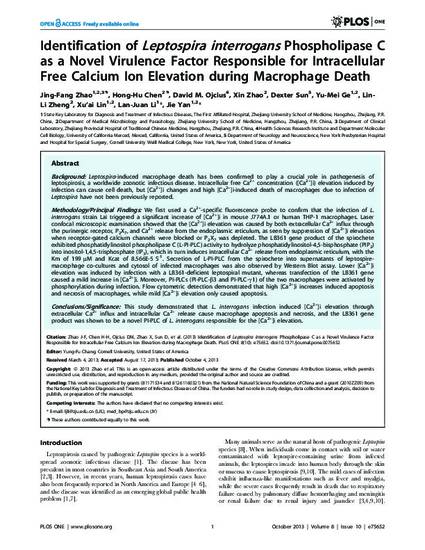
Background: Leptospira-induced macrophage death has been confirmed to play a crucial role in pathogenesis of leptospirosis, a worldwide zoonotic infectious disease. Intracellular free Ca2+ concentration ([Ca2+]i) elevation induced by infection can cause cell death, but [Ca2+]i changes and high [Ca2+]i-induced death of macrophages due to infection of Leptospira have not been previously reported.
Methodology/Principal Findings: We first used a Ca2+-specific fluorescence probe to confirm that the infection of L. interrogans strain Lai triggered a significant increase of [Ca2+]i in mouse J774A.1 or human THP-1 macrophages. Laser confocal microscopic examination showed that the [Ca2+]i elevation was caused by both extracellular Ca2+ influx through the purinergic receptor, P2X7, and Ca2+ release from the endoplasmic reticulum, as seen by suppression of [Ca2+]i elevation when receptor-gated calcium channels were blocked or P2X7 was depleted. The LB361 gene product of the spirochete exhibited phosphatidylinositol phospholipase C (L-PI-PLC) activity to hydrolyze phosphatidylinositol-4,5-bisphosphate (PIP2) into inositol-1,4,5-trisphosphate (IP3), which in turn induces intracellular Ca2+ release from endoplasmic reticulum, with the Km of 199 µM and Kcat of 8.566E-5 S-1. Secretion of L-PI-PLC from the spirochete into supernatants of leptospire-macrophage co-cultures and cytosol of infected macrophages was also observed by Western Blot assay. Lower [Ca2+]i elevation was induced by infection with a LB361-deficient leptospiral mutant, whereas transfection of the LB361 gene caused a mild increase in [Ca2+]i. Moreover, PI-PLCs (PI-PLC-β3 and PI-PLC-γ1) of the two macrophages were activated by phosphorylation during infection. Flow cytometric detection demonstrated that high [Ca2+]i increases induced apoptosis and necrosis of macrophages, while mild [Ca2+]i elevation only caused apoptosis.
Conclusions/Significance: This study demonstrated that L. interrogans infection induced [Ca2+]i elevation through extracellular Ca2+ influx and intracellular Ca2+ release cause macrophage apoptosis and necrosis, and the LB361 gene product was shown to be a novel PI-PLC of L. interrogans responsible for the [Ca2+]i elevation.
Available at: http://works.bepress.com/david-ojcius/116/
